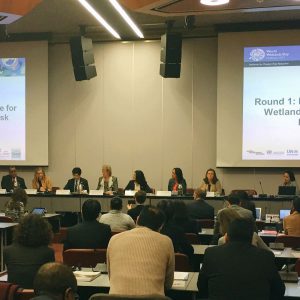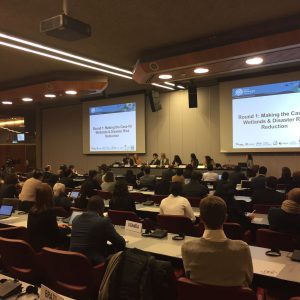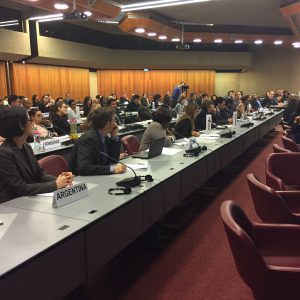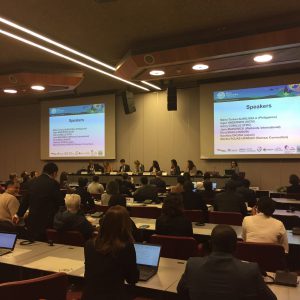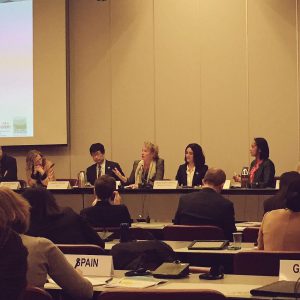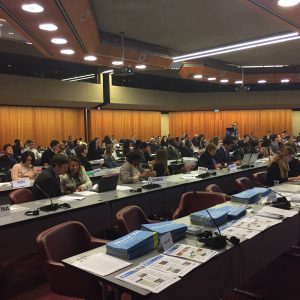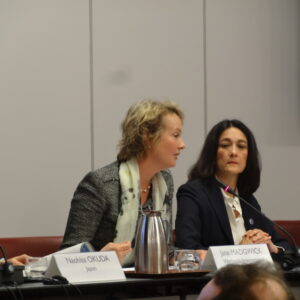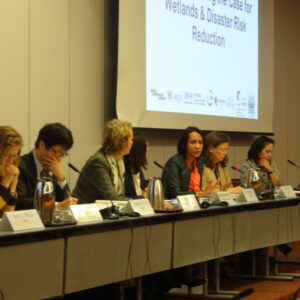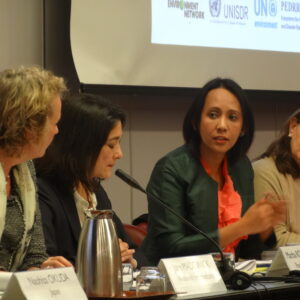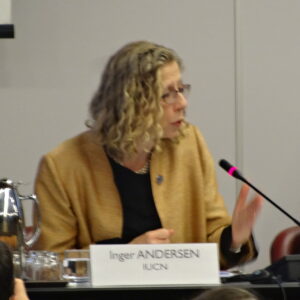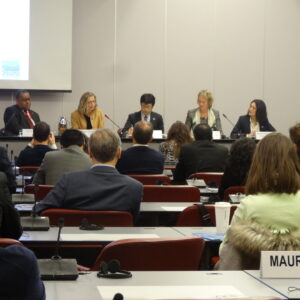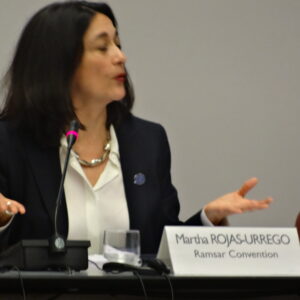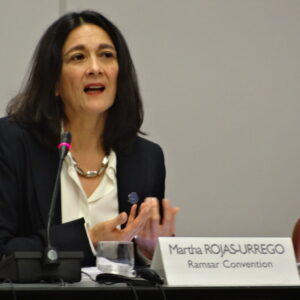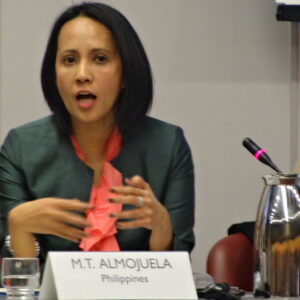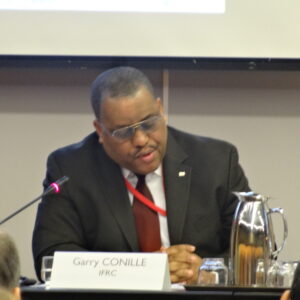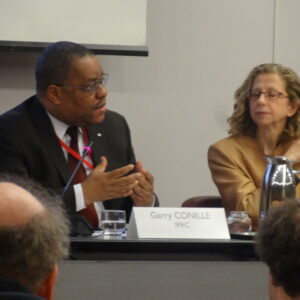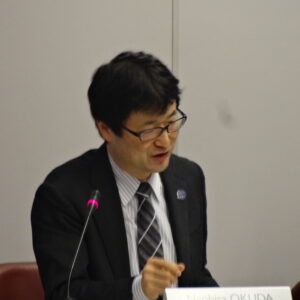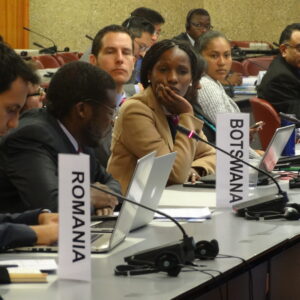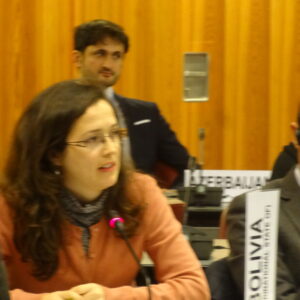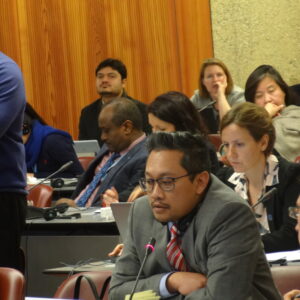Event Conference
World Wetlands Day 2017 Celebration | Healthy Wetlands, Resilient Communities
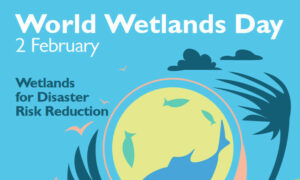
In celebration of World Wetlands Day 2017, this Roundtable Discussion featured the role of wetlands in protecting people and enhancing their resilience to disasters.
High-level Roundtable Discussion on “Healthy Wetlands, Resilient Communities”
The frequency of disasters worldwide has more than doubled in just 35 years. Disasters are a major setback to development, resulting in loss of lives, livelihoods, critical assets and disruption of services.
In celebration of World Wetlands Day 2017, this Roundtable Discussion featured the role of wetlands in protecting people and enhancing their resilience to disasters. It focused on how wetlands can be optimized for reducing the risk of flooding, including in urban areas, drought and windstorms and storm surges. Drawing from practical examples, the Roundtable discussed how sustainable wetlands management can contribute towards more resilient development.
The Roundtable represented different perspectives, including speakers from Governments, civil society, humanitarian and development agencies. The event, co-organized by the Ramsar Convention, the PEDRR Secretariat and the Geneva Environment Network Secretariat, in collaboration with Wetlands International, was conducted as an interactive, free-flowing dialogue between speakers as well as with the public audience.
Panelists
- Maria Teresa Almojuela | Charge d’Affaires, Permanent Mission of the Philippines to the United Nations, Geneva
- Inger Andersen | Director General, International Union for the Conservation of Nature (IUCN)
- Garry Conille | Under Secretary General of the International Federation of the Red Cross (IFRC)
- Kirsi Madi | Director of the UN Secretary General for Disaster Risk Reduction (UNISDR)
- Jane Madgwick | Chief Executive Officer, Wetlands International (WI), Chair of the Roundtable
- Naohisa Okuda | Director, Biodiversity Policy Division, Nature Conservation Bureau, Ministry of the Environment (MOEJ), Government of Japan
- Martha Rojas-Urrego | Secretary General, Ramsar Convention On Wetlands
Outcomes of the discussion
Outcomes of the discussion reflected on the following:
- Challenges and solutions in harnessing wetlands for disaster risk reduction;
- Opportunities for increasing/scaling-up investments in wetland management solutions for disaster risk reduction (including in post-disaster recovery and reconstruction).
The outcomes of the Roundtable are shared as a contribution to the 2017 Global Platform on Disaster Risk Reduction, which will be held on 22-26 May in Cancun, Mexico.
Summary
Welcoming Remarks
Martha Rojas-Urrego, Secretary General of the international community’s Ramsar Convention on Wetlands, opened the discussion by presenting the Ramsar Convention on wetlands. World Wetlands Day is celebrated every 2 February – when the convention was signed – and many events take place around the world. The convention has 2260 sites today. Why celebrating wetlands? Because they are one of the most productive but also the most endangered ecosystems around the world. They are very important for our planet’s biodiversity. More than 3 billion people depend on wetlands for their food, and 1 billion depend on them for water and their livelihoods. Finally, they act as buffers for natural disasters. For all of these reasons, awareness needs to be brought about their fragility. Deploying ecosystem protection as a means to curb the impact of hazards is a key tenet of the Sendai Framework for Disaster Risk Reduction, adopted in 2015. The 15-year Sendai Framework is the international community’s most comprehensive disaster risk reduction blueprint to date, and was the first building block of the 2030 Agenda for Sustainable Development.
Jane Madgwick, Chief Executive Officer at Wetlands International, offered the welcoming remarks. Three facts need to be kept in mind during this discussion. First of all, disasters and disasters risks are raising as time passes, and we see an increasing number of natural disasters such as earthquakes and storms. Secondly, 90% of these disasters are water-related, which explains why we are focusing on wetlands today, as they are the regulators of water. It explains why disasters are rising as wetlands are lost. Finally, these events are not really natural disasters, but disasters caused by the destruction of our surrounding environment. Jane then opened the discussion and directed questions to the panellists.
The Role of Wetlands in Disaster Risk Reductions
Every year, around twenty typhoons and hurricanes hit the Philippines. What could be the role of good environmental management in reducing the impacts?
The Philippines is a region that experiences natural disasters on a regular basis, introduced Ambassador Maria Teresa Almojuela, Deputy Permanent Representative and Chargé d’Affaires at the Permanent Mission of the Republic of the Philippines to the United Nations Office and other International Organizations in Geneva. Mangroves showed their mettle during the 2013 Typhoon Haiyan storm surge disaster. Maria gave shared the story of the Filipino coastal community of Palompon which was surrounded by a mangrove plantation that protects it from storms and typhoons. This community had earlier engaged with the department of education in making environmental management part of their requisite school training very early on.
The Philippines have 240 protected areas which are protected by the National Integrated Protected Areas System (NIPAS) Act of 1992. In the wake of these disasters which are a stark sign of the new normal, the Philippines brought together different arms of government to embed disaster risk reduction in its environmental policy. The experience of the Typhoon Haiyan also underlined the importance of elevating the level of consciousness of the population.
In 2011, Japan experienced an earthquake, leading to a devastating tsunami which caused 13’000 deaths. Were wetlands relevant to this event at all, and are they useful to manage other events?
What happened was a great tragedy, said Naohisa Okuda, the Director of the Biodiversity Policy Division of the Nature Conservation Bureau at the Japanese Ministry of the Environment (MOEJ). The Japanese government researched how it could prevent such damages. However, there is no clear evidence that the natural ecosystems did protect or prevent the damages caused by the tsunami. Nevertheless, land use is an important factor in Japan, even more as infrastructures do not always offer the required protection from disasters. Following this tragedy, the government developed a national plan which included an ecosystem based approach. The question now remains to determine how can this approach be implemented in the framework of that national plan.
Even though there are some disasters whose harm cannot be prevented, this example underlines the importance of putting the role of natural infrastructure into context. It is about finding the right combination in the right place.
Inger Andersen, the Director General of the International Union for the Conservation of Nature (IUCN), gave an overview of her experience in using wetlands for disaster risk reduction. Wetlands provide an incredible setting for reducing risks from natural disasters. Too many times, infrastructure would be built in a wetland area only to realise that this wetland was providing water and protection against natural disasters. In Senegal, the construction of the Diama Dam on the Senegal River estuary led thousands of farmers without a livelihood, as 1’000’000 hectares of wetlands and cultivable lands were immediately lost. When the government realised in the 1990’s that this infrastructure was a catastrophe for farmers, they worked with governments from around the world, IUCN included, to restore this wetland. Today, it’s a fantastic Ramsar site. Destroying wetlands leads to the destruction of entire food systems. The World Economic Forum classifies natural disasters as the main danger in the upcoming years. Businesses are increasingly paying attention to these matters, as they do not want to invest if there is any form of risk. In contrary, investing in nature-based solutions provides a free buffer that is well needed.
There is indeed an enormous risk in allowing wetlands loss and degradation. The Red Cross societies are having great difficulties in answering to the rising frequency and intensity of disasters. A lot of work is dedicated to preparedness. Where do wetlands fit in this topic? Are they figuring in the discussion about building resilience?
Garry Conille, the under Secretary General of the Programmes and Operations at the International Federation of the Red Cross and Red Crescent Societies (IFRC), underlined three points. First, ecosystems are major drivers of vulnerability. For this reason, supporting the assets and strengths of local communities is a good investment. Secondly, wetlands can serve as natural buffers from natural disasters. They can save lives. About 100km of mangroves in Vietnam protected the local populations from the 2002 typhoon. In Hikkaduwa, Sri Lanka, protected offshore coral reefs helped break the power of the 2004 Indian Ocean Tsunami so that damage extended just 50 metres inland. In nearby Peraliya, where coral mining had damaged the reefs, the damage extended 1.5 kilometres inland. Finally, it is important to empower communities and build their resilience through an integrated environmental management approach which involves both upstream and downstream communities. For all these reasons, an integrated risk management approach is the best solution when thinking about wetlands.
Building a Bridge Between the 2030 Sustainable Development Agenda and the Sendai Framework for Disaster Risk Reduction
We heard from our panellists that there is substantive evidence for linking wetlands to disaster risk reduction, declared Jane Madgwick. Green solutions work. However, it is important to call attention to this issue, as the investment is not flowing into the right direction. As an example, the Asian Development Bank has 6 billion to invest in climate change adaptation and disaster risk resilience, but governments do not require investment for green solutions. In parallel, as climate change takes on, there is an inclination to turn to more build infrastructures to protect people, but is this the best solution? What we witnessed so far are unintended consequences of economic development. We are experiencing upstream development such as major dams that might put others downstream in bigger risks.
How can we more systematically build in the values of wetlands into economic development?
It is a critically important issue, declared Kirsi Madi, Director of UNISDR. The standard framework is increasingly recognising the important role of wetlands. We have to build a commitment of understanding for the public and private sectors, to ensure they do not think on a short term level and consider all the risks and consequences when it comes to wetlands. There is a need to plan on the long-term and not to just focus on short-term gains. The Global platform in Cancun showed the importance of having a whole of society approach. The increasing role of the private sector should not be undermined. Actors are getting engaged through the UNISDR network, and we ask them to integrate disaster risk management in their agenda. Rgerading wetlands and ecosystems, good practices are being implemented. Mindful that companies are responsible for the bulk of investment in the built environment, in 2015 UNISDR and its partners set up the Private Sector Alliance for Disaster Resilient Societies (ARISE). Its projects include working with local governments and firms around the Gulf of Mexico to reduce the risk of a repeat of the 2005 Hurricane Katrina disaster, with measures including wetland restoration. Breaking down barriers between groups of policymakers is exactly the kind of approach advocated by UNISDR, which sees it as the key to success. Partnerships have to be created and all players have to be engaged to reduce disaster risk, including the private sector.
Even though there might not be sufficient knowledge yet to really make the change in terms of investments, facts say that wetlands are vital for the security of humanity. How can a bridge be built in that regard?
Martha Rojas-Urrego underlined that 64% of the world’s wetlands have disappeared in the past 100 years. The current rate of loss is 1% per year, faster than any other ecosystem. Wetlands are drained or degraded to meet the increasing demands for water and land to cater for agriculture, industry and a growing urban population. It is crucial that more voices speak up for wetlands, more people become informed of their value and more decisive actions are taken to conserve and restore this valuable ecosystem. Well-managed wetlands make communities resilient in the event of extreme weather and help to minimize the damage from these hazards. Coastal wetlands such as mangroves protect against flooding and serve as buffers against saltwater intrusion and erosion. Inland wetlands such as floodplains, lakes and peatlands absorb and store excess rainfall, which reduces flooding as well as delaying the onset of droughts by storing water. Wetlands also provide food for more than three billion people worldwide, are a source of fresh water for over one billion, and, by storing carbon dioxide, can slow the pace of global warming.
However, the evidence is not really being scaled up. The 169 governments who have signed the Ramsar Convention and committed to develop policies for the management of wetlands form an important platform of political commitment which needs to be replicated. In this regard, countries have to receive assistance for implementing their commitments. First, other sectors need to be included. Urban linkages could be made, for example, in order to get cities to invest in wetlands that they have around them to address disaster risk resilience. The city of Columbo in Sri Lanka could work on its surrounding mangroves to provide floods. Secondly, bridges must be built between different frameworks. The year of 2015 was amazing in terms of sustainable development and international policy making. Wetlands must be implemented through the SDG framework, namely in goal 6.6 – “By 2020, protect and restore water-related ecosystems, including mountains, forests, wetlands, rivers, aquifers and lakes and disasters.” – and goal 15.1 – “By 2020, ensure the conservation, restoration and sustainable use of terrestrial and inland freshwater ecosystems and their services, in particular forests, wetlands, mountains and drylands, in line with obligations under international agreements.” The same goes with the Paris Agreements on Climate Change. As disasters are increasing, these agreements lead countries to integrate wetlands conservation and restauration as part of their mitigation efforts and national action plans for climate change reduction. Wetlands store twice as much carbon than forests. This might help to get synergies, better investment and bring awareness for the conservation of wetlands. This allows to implement the convention and to help countries develop integrated approaches. It is a good way to scale up the action.
There is good and bad infrastructure and we need to understand the difference between the two, announced Inger Andersen. Nature has to be counted as an infrastructure too, and it has to be integrated into a holistic approach. When we invest we need returns for food, jobs, growth, biodiversity, climate. However, the different ministries are not specially trained to think like this. Water governance also has a role to play in this matter. For this reason, IUCN is working on various levels, including the industries and other various sectors. All of these interests need to be mapped and each level has to be understood. The fact that Japan has stepped up and taken a leadership in resilience has helped IUCN to show how nature can be an asset.
Community based management is one of the key, said Naohisa Okuda. Social scientists are studying the resilience of communities who understand the power of nature. In Japan, traditional knowledge plays an important role. The ecosystem-based approach is used on that traditional knowledge. Unfortunately, new industries and scientific progresses are making people forget the traditional ways.
Ramsar provides guidance to states on ecosystem-based solutions declared Maria Teresa Almojuela. These include the development and management of wetlands areas; the implementation of disaster risk reduction, climate change and adaptation strategies; and the promotion of increased knowledge based on wetlands – including the roles of indigenous peoples in wetlands management. In the Philippines, the challenge involves informing one hundred billion people on resilience, as capacity building is one of the government’s priority. In partnership with the Ramsar Convention, the government and national societies are getting involved in wetlands protection. The Coral Triangle Initiative in this region constitutes a big component of community’s capacity building. Biodiversity in Indonesia is crucial for the biodiversity of the whole world. It is also important to map what we know. The Philippines has launched a baseline-study for constituting an atlas of inland wetlands supposed to serve the government to identify key areas and protect more than 800 wetlands. New islands will be integrated in the upcoming steps. Finally, it is necessary to build synergies to develop common approaches. Protecting wetlands is a work with which struggle a lot of authorities. The Philippines is maintaining a very active partnership in this region, with Conservation International invested in public education and the ASEAN playing a very strong role in the whole of South-East Asia.
It is necessary to build expertise in different areas through partnerships and integrated approaches said Garry Conille. Resilience can only be done through a multi-stake holder partnership. First, institutions have to get involved at community level. Then, stakeholders from civil society organisations need to be integrated. Finally, partnerships have to be broaden to other partnerships.
Questions from the Permanent Missions
The Permanent Mission of Botswana first took the floor to recall that Botswana is part of the Ramsar sites, with 5 million hectares of lands registered so far. How is it possible to reconcile between the priorities of development in one hand and the protection of ecosystems and biodiversity on the other hand? How can we maintain world heritage sites all the while ensuring that communities can continue to thrive? Where do business communities fit in there?
Wetlands constitute 12% of our national territory announced the Permanent Mission of Uruguay. Directing its question to IUCN, the mission representative asked which panel would be the best opportunity to talk about the issue of wetlands for disaster risk reduction.
The Permanent Mission of Romania then took the floor to offer support under the form of the exchange of best practices and knowledge for the management of wetlands, having in mind the experience of Romania in this topic and the existence of two Ramsar sites in partnership with Bulgaria. The idea of developing a project in these trans-boundary Ramsar cites was brought up.
In relation to climate change and wetlands, the Permanent Mission of Ecuador wondered how the Paris Agreements could be implemented so that all the pressure on countries would go into mitigation actions and resources adaptation. This is a very important need, especially for developing counties. Secondly, the Mission raised the question of what could be the role of private sector actors – such as insurance companies – in the implementation of the Paris Agreement, as any reference with private companies was put aside, making it impossible for some countries to receive compensation for loss and damages from climate change.
The Permanent Mission of Bolivia underlined the importance of local communities and local knowledge in term of ecosystems management. In terms of partnerships with the private sector, the representative shared it was very important for countries to increase regulations, control and accountability. Sustainable and predictable financing is also of much importance. At the same time, awareness on the importance of wetlands should be raised. In this regard, synergies need to take into account different mandates, frameworks and opportunities. How would it be possible to replicate events such as the one today to share best practices and raise awareness?
If we think we can have all the food, the air and the water and not protect nature, we didn’t do the sums, declared Inger Andersen in reply to Botswana. All we need is originating from nature and we are today way beyond the planetary boundaries. Species are being lost at a 1’000 times the natural extinction rate. Ecosystems are under a great stress. A divergence could indeed be underlined, but nature underpins development nonetheless. It is not a question of nature versus development.
We need to look where synergies can come together, said Kirsi Madi. Sustainable development is not possible without addressing ecosystems and reducing risks. The most immediate target of 2020 is increasing the number of national strategies for disasters risk reduction. I hope wetlands will be brought into policies, and that more platforms will allow us to do this, effectively involving key actors.
In reply to Ecuador, Maria Teresa Almojuela declared that the Philippines have a disaster risk reduction law compiled with a periodic assessment. The government is studying a mandatory bill which will strengthen the features of the law with regards to resilience. With respect to ecosystem based solutions, this law will have a dedicated section on eco-system based approached to mitigate disasters and that communities are fit to face natural risks. This will allow to strengthen resilience policies and to elevate the current set up to a full pledge ministry and a twin centre for disaster risk management.
Businesses are already integrating an ecosystem based approach said Naohisa Okuda. The private sector should regularly communicate on this topic. In parallel, all relevant actors should publish their information, including key studies.
All of the delegations should engage with the Ramsar convention, especially towards the next COP in Dubai on urban systems, said Martha Rojas-Urrego. A specific point of the convention covers the topic of inventories. The fact that parties have committed to do inventories of wetlands is very important for integrating different agendas and implementing the SDGs. We need to ensure that countries do not need to do this twice and that all the parties’ efforts converge and merge. In reply to Ecuador, it is clear that climate change is having an impact in terms of disasters. The potential of wetlands are not part of the common knowledge. In the Paris agreement, wetlands can be taken it into account in two ways: first as the greenhouse gas inventories (carbone stored in wetlands can be counted there); secondly as integrated in the Intended Nationally Determined Contributions (INDCs). This consists in a typical win-win agenda, as countries can contribute in achieving their parts of the Paris Agreement in terms of reducing CO2 emissions by conserving their wetlands. And there is support for countries trying to achieve these goals, such as the green climate change fund and the private sector.
Many wetlands are being lost, declared the Permanent Mission of Iran and the ecosystems disappear with them. Contribution from the international community should be made to countries trying to protect them. The role of wetlands should be highlighted in the fight in climate change.
The Permanent Mission of Indonesia recognised that the archipelago is at the same time blessed for it wetlands and cursed for its disasters. The government is very keen on emphasising on the role of science when facing disasters and rehabilitating natural areas lost to fire and typhoons. Science could also help us to identify an inventory of the different wetland ecosystems, such as corals. Many knowledge gaps remain and for that reason a lot more cooperation from all stakeholders, including governments and universities, would be needed in this matter.
Closing Remarks
Jane Madgwick offered concluding arguments. The issue is starting to be not so much about whether wetlands are needed to reduce risks, but about how we can get an integrated approach to implement this concept. This is very encouraging. We first need to better understand risks, and science indeed needs to get involved, including social science, technology and traditional knowledge. Secondly, infrastructure has to adapt so it can be compatible with green solutions. Thirdly, we see many promising national frameworks, and great partnerships are formed around the world. As we move into Cancun, we can identify these new networks and make them work together. This is not just about conservation wetlands, it is about the whole land water management. Community land management is a bottom-up approach really relevant in this context and needs to be encouraged. Finally, cities might be major players in the future in preserving wetlands.
For all of this to work out we need political will, and a core group of countries are increasingly getting involved. The Ramsar Convention has an opportunity to help connect this issue across the different sectors. The private sector could have a great impact, but we need to ensure they are getting involved for the good reasons. The humanitarian sector has a massive role to play and might have more impact as some sustainable development organisations as they push governments to reflect on their situation. We need more guidelines, examples and sharing of good practices and this is something we can look forward at Cancun.
Martha Rojas-Urrego thanked all participants for being here and the GEN for helping with the organisation. The opportunity to act on this situation is huge. It is now up to us to raise awareness on the potential of wetlands.
Documents
Resources and Links
World Wetlands Day Globally
- Find out more at: http://www.worldwetlandsday.org/en
PEDRR Network
UNISDR
- Outcome of the event: Protect wetlands to reduce disaster risk

